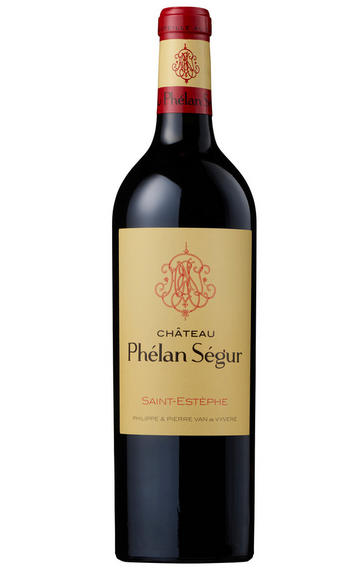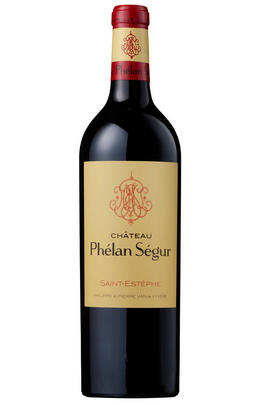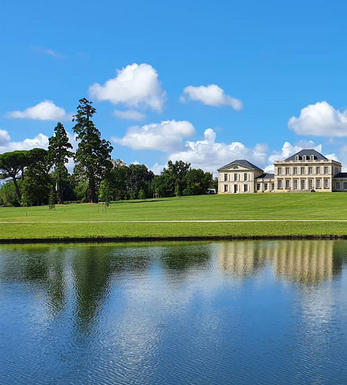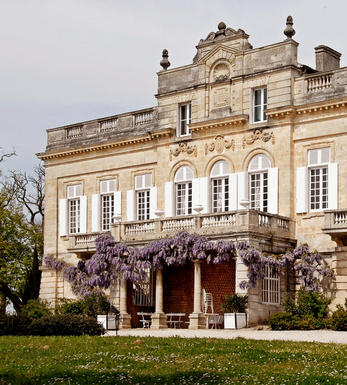
2021 Château Phélan Ségur, St Estèphe, Bordeaux

Critics reviews
The 2021 Phélan Ségur has an attractive bouquet of blackberry, raspberry and dried rose petal scents, quite fragrant and appealing even at this early stage. The palate is medium-bodied with sappy red fruit, fine tannins, well-judged acidity and quite a tensile finish. This is very promising, though it will need four to five years in bottle. It might represent one of the best values for money… depending on the release price, of course.
Drink 2027 - 2050
Neal Martin, vinous.com, (May 2022)
Drink 2024 to 2036
Jane Anson, Inside Bordeaux (May 2022)
Cask sample. Deep purple. Deep flavours on the nose – intense! Drier, perhaps more ‘serious’ than de Pez. Fully ripe flavours but still quite youthful with marked tannins on the end. Real drive here as well as length. And a dry, almost drying, finish. Not flattering but true to the appellation.
James Lawther, jancisrobinson.com (May 2022)
Unfurling in the glass with aromas of dark berries, plums and cherries mingled with notions of rose petals, pipe tobacco, sweet spices and loamy soil, the 2021 Phélan Ségur is medium to full-bodied, deep and layered, with impressive depth at the core, ripe tannins and lively acids, concluding with a long, saline finish. Concentrated and well-constructed, this is a serious wine with a bright future ahead of it. It's a blend of 75% Cabernet Sauvignon, 21% Merlot and 4% Petit Verdot. Tasted five times, twice at the estate.
William Kelley, Wine Advocate (Apr 2022)
Plenty of cabernet character with currant and blackberry and some fresh-herb undertones. Medium body. Fine, firm tannins. Refined and together. Oyster shell and hints of spices such as cloves and white pepper. Tapenade. Typical for the appellation. 75% cabernet sauvignon, 4% petit verdot and 21% merlot.
James Suckling, jamessuckling.com (May 2022)
About this WINE

Château Phélan Ségur
Château Phélan-Ségur is a St Estèphe property that produces textbook meaty, solid and long-lived St Estèphe. Founded by Irishman Bernard O’Phelan, the estate was developed by his son, Frank, and renamed Phélan Ségur in the early 20th century. It was bought by Xavier Gardinier in 1985 and run by his sons, Thierry and Laurent until 2018, when Philippe Van de Vyvere bought the property.
Phélan-Ségur's 70 hectares of vineyards are well-sited near the Grionde estuary, lying on well-drained gravel soils, bordered by those of Château Montrose and Château Calon-Ségur.
The grand vin is normally a blend of at least 60% Cabernet Sauvignon, with Merlot and a touch of Cabernet Franc and/or Petit Verdot. The grapes are fermented in temperature-controlled stainless steel vats and the wine is then matured in oak barriques (maximum 50% new) for 16 months. Phélan Ségur usually requires at least five to seven years of bottle ageing to show at its best, and the finest vintages can continue improving for up to 15 years.

Saint-Estèphe
Saint-Estèphe is the northernmost of the most important communes of the Médoc and borders Pauillac on its southernmost border, with only a gully and stream separates it from Ch. Lafite. To the north lies the Bas-Médoc.
Saint-Estèphe is defined by the depth of its gravel, which is ubiquitous but of varying depths and occasionally very shallow, when clay predominates. This keeps the soil cooler and wetter than its counterparts so that the wines can appear fresh in lighter vintages, but superbly successful in hot, dry years.
The best châteaux in the south of the commune have the deepest soil and the thickest gravel. Cos d'Estournel has an exceptional terroir with its vineyards being located on a south-facing ridge of gravel with excellent drainage.
Saint-Estèphe is the least gravelly of main Médoc communes and in the north of the commune the vineyards are heavier and more clay-based leading to a rustic style of wine being produced.
The wines can appear austere in youth with a discernable ferric note at some châteaux, but the best typically display good depth of colour, pronounced acidity an tannins in youth and are exceptionally long-lived. At their best, they are the equal of almost any Bordeaux. The well-regarded St Estèphe co-operative controls the production of about half the appellation.
Recommended Châteaux
Cos (Ch. Cos d'Estournel), Ch. Montrose, Ch. Calon-Ségur, Ch. Lafon-Rochet, Ch. Les Ormes de Pez, Ch. Beau-Site, Ch. Cos Labory, Ch. Phélan-Ségur

Cabernet Sauvignon Blend
Cabernet Sauvignon lends itself particularly well in blends with Merlot. This is actually the archetypal Bordeaux blend, though in different proportions in the sub-regions and sometimes topped up with Cabernet Franc, Malbec, and Petit Verdot.
In the Médoc and Graves the percentage of Cabernet Sauvignon in the blend can range from 95% (Mouton-Rothschild) to as low as 40%. It is particularly suited to the dry, warm, free- draining, gravel-rich soils and is responsible for the redolent cassis characteristics as well as the depth of colour, tannic structure and pronounced acidity of Médoc wines. However 100% Cabernet Sauvignon wines can be slightly hollow-tasting in the middle palate and Merlot with its generous, fleshy fruit flavours acts as a perfect foil by filling in this cavity.
In St-Emilion and Pomerol, the blends are Merlot dominated as Cabernet Sauvignon can struggle to ripen there - when it is included, it adds structure and body to the wine. Sassicaia is the most famous Bordeaux blend in Italy and has spawned many imitations, whereby the blend is now firmly established in the New World and particularly in California and Australia.


Buying options
Add to wishlist
Description
Cabernet Sauvignon 75%, Merlot 21%, Petit Verdot 4%
Véronique Dausse wasn’t alone in finding the Merlots compromised by mildew, but what survived gave crunchy and vivid fruit. It’s the Cabernet Sauvignon that carries this vintage, however. Phélan Ségur has been on a hot streak since it was bought by Philippe Van de Vyvere in 2017. Although in a tighter, more serried style than the last three vintages, there is plenty to admire here. The bouquet is feistily St Estèphe: spice and liquorice over sapid red fruits, with firm, salty tannins. This is very good and true to type. Drink 2026-2040.
Our score: 16/20
Berry Bros. & Rudd, April 2022
wine at a glance
Delivery and quality guarantee